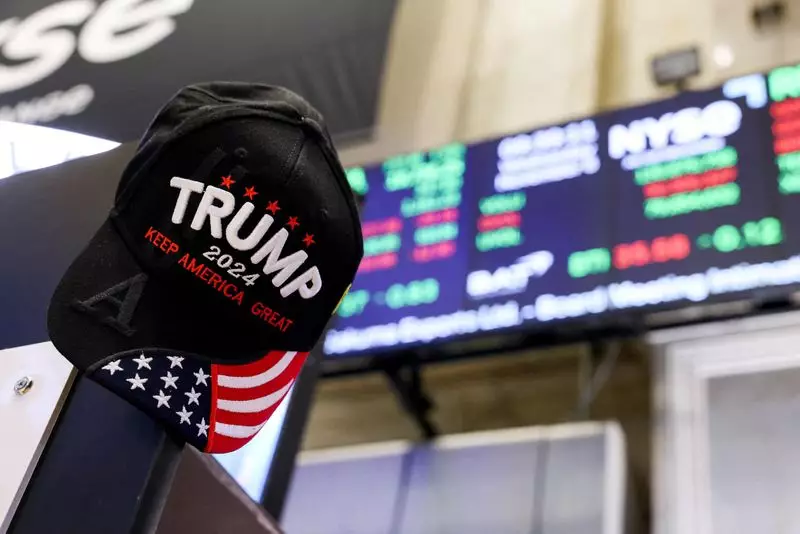In recent months, U.S. stock markets have maintained a trajectory of growth that stands in stark contrast to their international counterparts. With the S&P 500 accumulating gains exceeding 24% in 2024, investors are keeping a watchful eye on the potential implications of the incoming presidential administration under Donald Trump. Many analysts suggest that if the President-elect can enact his proposed economic agenda without sparking a full-scale trade war or significantly increasing the federal deficit, the U.S. might further solidify its market dominance.
Compared to a benchmark of over 40 international markets, the valuation of the S&P 500 is not only higher but also at its peak in over two decades, as per LSEG Datastream. This divergence highlights a long-standing trend where U.S. stocks have consistently outperformed their global counterparts, yet the ongoing economic climate exacerbates this disparity. A burgeoning technology sector, particularly the noteworthy advancements in artificial intelligence, has fueled a surge in stock prices of key players like Nvidia, further solidifying U.S. positions.
Central to the success narrative of U.S. equities is robust corporate profitability. Earnings projections for companies listed on the S&P 500 indicate a healthy growth trajectory of approximately 9.9% this year, with forecasts of 14.2% for 2025. Conversely, Europe is facing a sluggish earnings outlook, with the STOXX 600 expecting a mere 1.8% growth this year and around 8.1% next year.
This disparity in earnings growth underpins a crucial factor — the significant impact of major technology companies within the U.S. stock market. Firms such as Nvidia, Apple, Microsoft, Amazon, and Alphabet command combined valuations exceeding $14 trillion, dwarfing the entire STOXX 600’s market valuation of about $11 trillion. The overall economic growth forecast for the U.S. stands at an impressive 2.8% for 2024, positioning the country favorably when compared to a modest 0.8% anticipated for a group of euro-using countries.
The implications of Trump’s policies, particularly regarding taxation, deregulation, and trade, are pivotal to understanding U.S. market strength. Analysts project that initiatives such as tax cuts could serve as engines for growth, while deregulation promises to spur further investment. However, there exists a duality to these policies; they could similarly precipitate inflation and economic upheaval if pushed to extremes.
Market participants are already exhibiting a clear bias toward U.S. stocks, evidenced by significant inflows into U.S. equity funds immediately following the election. Financial strategists from esteemed institutions like Morgan Stanley, UBS Global Wealth Management, and Wells Fargo advocate for an overweight position in U.S. equities amid these promising indicators.
While optimism pervades the U.S. stock market narrative, potential pitfalls loom in the shadows. The specter of an all-encompassing trade war, particularly with China and key trading partners, poses substantial risks that could derail economic momentum. Predicted scenarios suggest that aggressive tariff impositions could trigger retaliatory actions from other nations, culminating in decreased growth and heightened inflationary pressures.
Concerns are amplified in sectors vulnerable to policy disruption. For instance, announcements of intended bureaucratic cuts have already put pressure on government contractors, while healthcare stocks reacted negatively to the appointment of vaccine skeptic Robert F. Kennedy Jr. to a significant health role in the new administration. Moreover, expansive tax cuts, if perceived as amplifying national debt, could lead to increased volatility in U.S. bond markets, prompting shifts in investor sentiment.
Despite short-term uncertainties, the long-term trend favors U.S. markets, which have realized more than an 180% gain over the past decade compared to a mere 50% uptick for Europe’s STOXX. Market momentum, driven by several factors including the upcoming potential for lower interest rates and advancements in technology, appears to be firmly on the side of U.S. equities.
Investors are positioned at a crossroads, weighing the benefits of unprecedented growth against looming risks inherent in political and global economic landscapes. As the U.S. continues to set itself apart from broader international markets, the decisions made in the coming year will have profound implications on the sustainability of this lead. The balance between growth strategies and the prevention of inflationary impacts will ultimately dictate the trajectory of U.S. equities as they navigate through an unpredictable global financial environment.

